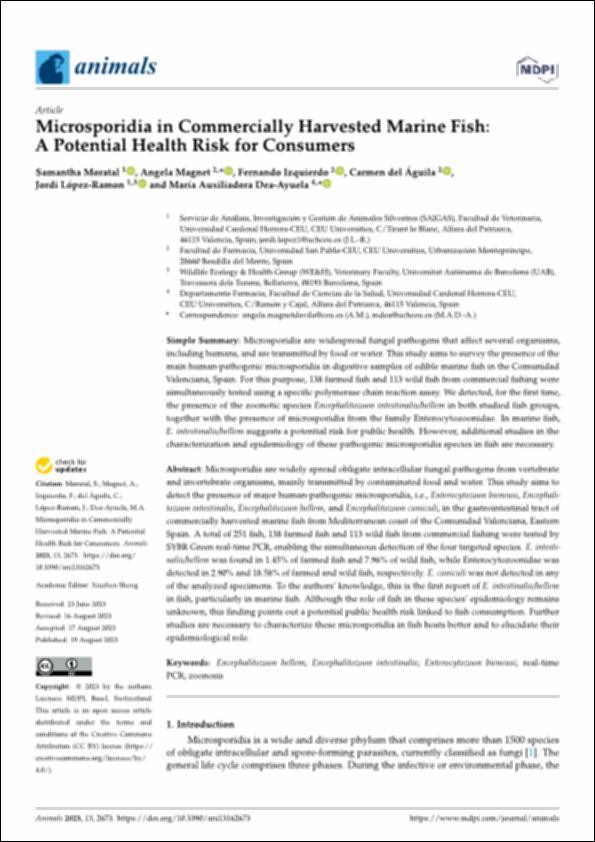Please use this identifier to cite or link to this item:
http://hdl.handle.net/10637/14920Microsporidia in commercially harvested marine fish: a potential health risk for consumers
| Title: | Microsporidia in commercially harvested marine fish: a potential health risk for consumers |
| Authors : | Moratal, Samantha Magnet, Angela Izquierdo Arias, Fernando Águila de la Puente, Carmen del López Ramon, Jordi Dea Ayuela, María Auxiliadora |
| Keywords: | Enfermedad transmisible; Infectious diseases; Veterinaria; Veterinary medicine; Epidemiología; Epidemiology; Consumo alimenticio; Food consumption; Parasitología; Parasitology; Pez marino; Marine fish |
| Publisher: | MDPI |
| Citation: | Moratal, S., Magnet, A., Izquierdo, F., Del Águila, C., López-Ramon, J. & Dea-Ayuela, M.A. (2023). Microsporidia in commercially harvested marine fish: a potential health risk for consumers. Animals, vol. 13, i. 16 (19 aug.), art. 2673. DOI: https://doi.org/10.3390/ani13162673 |
| Abstract: | Microsporidia are widely spread obligate intracellular fungal pathogens from vertebrate and invertebrate organisms, mainly transmitted by contaminated food and water. This study aims to detect the presence of major human-pathogenic microsporidia, i.e., Enterocytozoon bieneusi, Encephalitozoon intestinalis, Encephalitozoon hellem, and Encephalitozoon cuniculi, in the gastrointestinal tract of commercially harvested marine fish from Mediterranean coast of the Comunidad Valenciana, Eastern Spain. A total of 251 fish, 138 farmed fish and 113 wild fish from commercial fishing were tested by SYBR Green real-time PCR, enabling the simultaneous detection of the four targeted species. E. intestinalis/hellem was found in 1.45% of farmed fish and 7.96% of wild fish, while Enterocytozoonidae was detected in 2.90% and 18.58% of farmed and wild fish, respectively. E. cuniculi was not detected in any of the analyzed specimens. To the authors’ knowledge, this is the first report of E. intestinalis/hellem in fish, particularly in marine fish. Although the role of fish in these species’ epidemiology remains unknown, this finding points out a potential public health risk linked to fish consumption. Further studies are necessary to characterize these microsporidia in fish hosts better and to elucidate their epidemiological role. |
| Description: | Este artículo pertenece al número especial "The Epidemiology, Diagnosis and Prevention of Infectious Diseases in Wildlife". |
| URI: | http://hdl.handle.net/10637/14920 |
| Rights : | Open Access http://creativecommons.org/licenses/by/4.0/deed.es |
| ISSN: | 2076-2615 (Electrónico) |
| Issue Date: | 19-Aug-2023 |
| Center : | Universidad Cardenal Herrera-CEU |
| Appears in Collections: | Dpto. Producción y Sanidad Animal, Salud Pública Veterinaria y Ciencia y Tecnología de los Alimentos |
Items in DSpace are protected by copyright, with all rights reserved, unless otherwise indicated.


